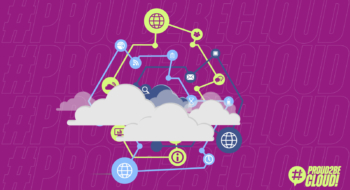Amazon S3
“Amazon S3 is an object storage service created to memorize and restore any volume of data from any source. It is a service that provides extremely durable, readily available storage infrastructure with unlimited scalability, at a lower cost.”
We will use S3 both as a source for files that make up the front-end application and as storage for user-uploaded files. Using this service allows for a virtually unlimited, highly-available space at a lower cost.
To make the implementation more secure, we will use two separate buckets to subdivide better permissions and keep application storage strictly isolated from user data storage.The bucket reserved for static assets will be the source for the CDN utilized to distribute the front-end to clients.
CloudFront
“Amazon CloudFront is a global Content Delivery Network (CDN) that allows the distribution of data, videos, applications, and APIs to users with minimal latency and high transfer rates.”
We will use CloudFront to serve the front-end of our application. In addition to improving performance and user experience, it also provides protection against DDoS attacks and reduces access costs to S3 for files that are frequently requested.
DynamoDB
“Amazon DynamoDB is a non-relational database that provides reliable performance on any scale. It is a multi-master, multi-region, fully-managed database that provides a constant latency of a few milliseconds, integrated security, a backup and restore service and a memory cache.”
DynamoDB wins over other valid DBMS because the application saves metadata related to the uploaded files and their sharing settings, where everything is strong “file centric.” The data structure fits well with the key-value model of DynamoDB, a condition which among other things is made possible by delegating the management of authorizations and user information to Cognito.
Furthermore, by choosing to use DynamoDB, the application benefits from a database in an almost fully automatic way. The database is fully managed, readily available, and easily and automatically horizontally-scalable.
Cognito
“Amazon Cognito allows tools to be quickly and easily added for logging, access and Web app and mobile device access controls. Amazon Cognito allows resources to be recalibrated for millions of users and supports access with social identity providers like Facebook, Google and Amazon and corporate identity providers via SAML 2.0.”
We chose to delegate authentication and user data management to a managed service. This allows us to limit the attack perimeter of the service we’re building, increase login and authentication possibilities, and provide a fast, bulletproof integration with API Gateway. The latter allows us to reduce costs because all the effort of authentication is carried out by the gateway and does not affect the Lambdas’ calculation time. Furthermore, any incorrect login attempts or calls made with expired or incorrect tokens will never reach the application but will be handled directly on the architecture’s outer perimeter.
The managed user data service also allows us to eliminate database traffic to find key information about users. It minimizes maintenance, the securing of tables with sensitive data, and credential management.
Lambda
“AWS Lambda allows code to be run without having to manage servers or carry out provisioning. Rates are calculated based on processing times, so no charges are made when the code is not running.”
The back-end will be developed entirely with AWS Lambda. This technology — key to the serverless philosophy — allows us to pay for single operations and only for the time it is actually used, eliminating wastage of processing power and costs when the system is idle. It also saves us from having to configure and test an adequate auto-scaling policy.
API Gateway
“Amazon API Gateway is a fully managed service that simplifies for developers the creation, publication, maintenance, monitoring, and protection of APIs on any scale.”
In this case, it’s an obvious choice; only AWS API Gateway has all the hooks and integrations necessary for seamless and effective assimilation into the application architecture. The main goal is to provide a readily available, high performance, reliable interface for back-end lambda functions. It also allows integration with Cognito for authenticating calls and passing them on to the back-end only if they are correctly authenticated and legitimate, effectively blocking all invalid requests. Another advantage is that we can easily integrate CloudFront to cache the back-end responses in order to reduce computing times and, at the same time, increase application responsiveness by reducing latency.









